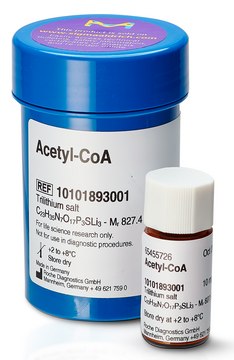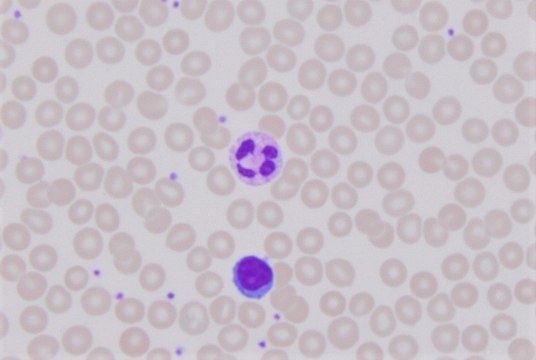MAK039
Acetyl-Coenzyme A Assay Kit
sufficient for 100 fluorometric tests
Synonym(s):
Acetyl-CoA Assay Kit
Select a Size
Select a Size
About This Item
Recommended Products
usage
sufficient for 100 fluorometric tests
detection method
fluorometric
relevant disease(s)
cancer; neurological disorders
storage temp.
−20°C
General description
Acetyl-Coenzyme A acts as an indicator of fat, sugar, and protein levels and shows up on the nutritional status. Thus, starvation greatly reduces the level of acetyl-CoA, which stimulates the process of autophagy. In lowered glucose condition, acetyl-CoA participates in the production of ATP. Increased acetyl-CoA levels are observed in prostate cancer due to elevated fatty acid utilization and thus provides an additional energy source for the tumor cell growth. Nutrition deprivation, changes the levels of certain metabolites, including acetyl-CoA, which stimulates epigenetic modifications that would affect the central nervous system.
Application
Suitability
Principle
related product
Signal Word
Danger
Hazard Statements
Precautionary Statements
Hazard Classifications
Eye Irrit. 2 - Resp. Sens. 1 - Skin Irrit. 2 - STOT SE 3
Target Organs
Respiratory system
Storage Class Code
10 - Combustible liquids
Flash Point(F)
188.6 °F - closed cup
Flash Point(C)
87 °C - closed cup
Regulatory Information
Choose from one of the most recent versions:
Certificates of Analysis (COA)
Don't see the Right Version?
If you require a particular version, you can look up a specific certificate by the Lot or Batch number.
Already Own This Product?
Find documentation for the products that you have recently purchased in the Document Library.
Which document(s) contains shelf-life or expiration date information for a given product?
If available for a given product, the recommended re-test date or the expiration date can be found on the Certificate of Analysis.
How do I get lot-specific information or a Certificate of Analysis?
The lot specific COA document can be found by entering the lot number above under the "Documents" section.
How do I find price and availability?
There are several ways to find pricing and availability for our products. Once you log onto our website, you will find the price and availability displayed on the product detail page. You can contact any of our Customer Sales and Service offices to receive a quote. USA customers: 1-800-325-3010 or view local office numbers.
What is the Department of Transportation shipping information for this product?
Transportation information can be found in Section 14 of the product's (M)SDS.To access the shipping information for this material, use the link on the product detail page for the product.
Can these kits be used with serum samples from mouse?
Yes, this kit can be used on mouse serum samples. We generally recommend that fresh serum samples be used. Frozen samples can probably be used. However, the successful use of frozen samples depends on the efficiency of freezing them and the amount of time they have been frozen. If previously frozen serum samples are used, you may want to check the performance of the kit with fresh vs. frozen samples.
My question is not addressed here, how can I contact Technical Service for assistance?
Ask a Scientist here.
Articles
Sigma article discusses tumor cell metabolic pathways, focusing on aerobic glycolysis and mitochondrial activity.
Warburg effect enhances glucose to lactate conversion in tumor cells, regardless of oxygen levels; impacting cancer metabolism since 1924.
Fatty acid synthesis supports cancer cell proliferation, essential for membrane generation, protein modification, and bioenergetics.
Our team of scientists has experience in all areas of research including Life Science, Material Science, Chemical Synthesis, Chromatography, Analytical and many others.
Contact Technical Service




